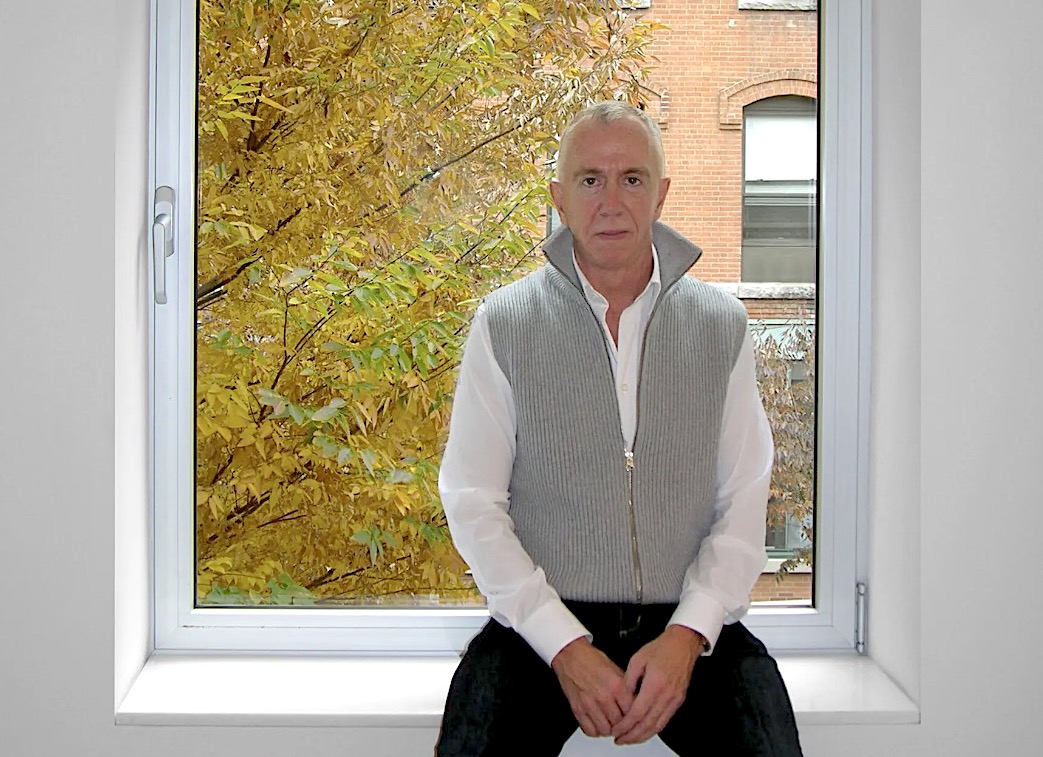Perro en Tlalpan (Dog in Tlalpan)
1992
16H x 20W inches
Gabriel Orozco
Gabriel Orozco often documents found situations in the natural or urban landscape. He travels armed with his camera and insightfully captures scenes of the everyday that other people might ignore. Perro en Tlalpan (Dog in Tlalpan, 1992) is a photograph of a dog regally perched under an industrial shelter in the borough of Tlalpan in Mexico City. The shelter’s concrete form seems to reference monuments such as the Mesoamerican pyramids in Teotihuacan, not far from the city, thereby likening the dog in a humorous way to some kind of posed sacred creature.
Gabriel Orozco could be described as a traveler-artist, without a fixed studio. He works following contexts and produces work that flows. “Special Service” (1997) is a collage on a plane ticket, and indicates nomadism, between territories. The artist, who is the son of muralist Mario Orozco Riviera, questions the boundaries of his artistic identity in Mexico. In “Crazy tourist” (1991), Orozco creates a situation with oranges in the Brazilian market tables in a desert. The artist uses objects or “poor” situations, found in the everyday landscape, natural or urban. By their division, their juxtaposition, or collage, inventing semantic or sensitive scenarios, always surprising, sometimes humorous and sometimes lyrical … The sculptural practice of the artist, inseparable from his drawings, photographs, or films, invents relationships of space, and disrupts our perception of objects. Such is the case of “Yielding Stone” (1992), a photo of a plasticine ball, the weight of the artist, rolled through the streets of New York. Gabriel Orozco was born in 1962 in Jalapa, Mexico. He lives and works in New York, Mexico, and Paris.
Colors:
Related works of genres: » born 1962, » relational art, » mexican contemporary artists, » contemporary artist, » conceptual and installation artist

© » KADIST
Diana Thater
2005In Perpetual Motion (2005) the seemingly erratic flight of the bright orange Monarch butterfly—filmed in its winter habitat of Michoacán, Mexico—is intensified by the artist’s editing in which frames are randomly dropped and the film is sped up...

© » KADIST
Francis Alÿs
2006This series of small drawings is executed with varying materials—pen, ink, colored pencil, charcoal, and masking tape—on architect’s tracing paper...

© » KADIST
Kara Walker
2005In her masterpiece 8 Possible Beginnings or The Creation of African-America , Walker unravels just that, the story of struggle, oppression, escape and the complexities of power dynamics in the history following slave trade in America...

© » KADIST
Carlos Amorales
2006This work, a large oil painting on canvas, shows a moment from Amorales’s eight-minute two-channel video projection Useless Wonder (2006)...

© » KADIST
Harun Farocki
2009For Immersion , Harun Farocki went to visit a research centre near Seattle specialized in the development of virtual realities and computer simulations...

© » KADIST
Sebastián Díaz Morales
2014In Suspension a young man is hanging in the air, falling, or perhaps drifting through time and space...

© » KADIST
Martin Creed
2003This photograph of Martin Creed himself was used as the invitation card for a fundraising auction of works on paper at Christie’s South Kensington in support of Camden Arts Centre’s first year in a refurbished building in 2005...

© » ARTLYST
Kara Walker
Brent Sikkema, the Manhattan art dealer renowned for representing artists such as Jeffrey Gibson and Kara Walker found dead The post Brent Sikkema – Visionary Art Dealer Of Jeffrey Gibson And Kara Walker Murdered appeared first on Artlyst ....

© » KADIST
Douglas Gordon
2002Blind Spencer is part of the series “Blind Stars” including hundreds of works in which the artist cut out the eyes of Hollywood stars, in a symbolically violent manner...

© » KADIST
Abraham Cruzvillegas
2004Wright Imperial Hotel (2004) is a sort of bow and arrow made out of feathers, a São Paulo phone book, and other materials...

© » KADIST
Martin Kippenberger
1989Untitled is a work on paper by Martin Kippenberger comprised of several seemingly disparate elements: cut-out images of a group of dancers, a japanese ceramic vase, and a pair of legs, are all combined with gestural, hand-drawn traces and additional elements such as a candy wrapper from a hotel in Monte Carlo and a statistical form from a federal government office in Wiesbaden, Germany...

© » KADIST
Félix González-Torres
1992Behind the simplicity and beauty of this untitled photograph of a brilliantly-colored flowerbed by Félix González-Torres are two remarkable stories of love, loss, and resilience...

© » KADIST
Jonathan Monk
2003Untitled (rolled up) , is an abstract portrait of Owen Monk, the artist’s father and features an aluminum ring of 56.6 cm in diameter measuring 1.77 cm in circumference, the size of his father...

© » KADIST
Francis Alÿs
2004The Nightwatch , which is an ironic reference to the celebrated painting by Rembrandt, follows the course of a fox wandering among the celebrated collections of the National Portrait Gallery in London...

© » KADIST
Martin Kippenberger
1988Martin Kippenberger’s late collages are known for incorporating a wide range of materials, from polaroids and magazine clips to hotel stationery, decals, and graphite drawings...

© » KADIST
Miguel Calderon
2009Tropical Vulture is a cross-generational project which highlights the artistic influences between George Kuchar, a Bay Area legend of independent filmmaking, and Mexican artist Miguel Calderón...

© » TATE EXHIBITIONS
Martin Creed
Martin Creed | The Dick Institute Experience the work of one of this country’s most ingenious, audacious and surprising artists at the Dick Institute ARTIST ROOMS Martin Creed presents highlights from the British artist’s thirty-year career...



